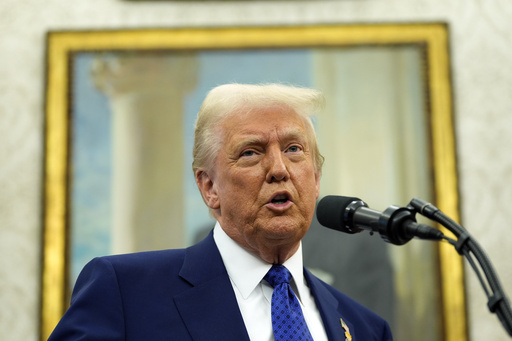In a recent announcement, President Donald Trump declared an intention to raise tariffs in the U.S. to match the rates imposed by other nations on imported goods. This bold move was highlighted in a post on his social media platform, Truth Social, where he expressed confidence in the initiative, urging his followers to “MAKE AMERICA GREAT AGAIN!!!”
Later the same day, Trump scheduled a press conference at the Oval Office to discuss these tariffs, which led to speculation about whether he would be signing official documents or simply laying out his reasoning to the American public while contemplating further detailed policies. The implications of such significant tariff increases could potentially disrupt the global economy, leading to reduced growth and heightened inflation. Although Trump argues that these measures would create domestic manufacturing jobs, many economists warn that they effectively act as a tax on U.S. consumers, exacerbating inflationary trends.
In recent weeks, Trump has shown a tendency to provoke various trading partners, issuing threats of tariffs and inviting retaliatory measures that could escalate into a trade war. Among his actions includes a 10% tariff on Chinese imports tied to the country’s involvement in producing fentanyl, as well as plans to impose tariffs on Canada and Mexico, the U.S.’s top trading partners—this latter set to begin next month after a temporary suspension. Furthermore, Trump has amended his previous steel and aluminum tariffs by removing exemptions, and he has hinted at new tariffs on items like computer chips and pharmaceutical products.
Counteractions are already on the table from the European Union, Canada, and Mexico, aimed at delivering economic repercussions to the U.S. in light of Trump’s actions. China has also retaliated, imposing tariffs on American goods including energy products, agricultural machinery, and larger vehicles, alongside initiating an antitrust probe into Google.
The specifics of what Trump means by “reciprocal tariffs” remain ambiguous. It is uncertain whether his upcoming order will strictly relate to matching tariffs or encompass other taxes imposed by foreign nations that they perceive as barriers to American exports. The White House contends that aligning import taxes with that of other countries enhances trade fairness, potentially benefiting U.S. government revenues and enabling better trade negotiations in the future.
Politically, Trump seems to be gambling that voters will accept an uptick in inflation. The spikes in prices during 2021 and 2022 hurt the approval ratings of then-President Joe Biden, with voters frustrated enough by rising costs to favor Trump. Inflation levels have continued to rise since the November elections, with the consumer price index recently noted at an annual rate of 3%.
The Trump administration has dismissed criticisms regarding the tariffs while conceding that there may be economic ramifications. They argue that the tariffs should be evaluated alongside the potential extension and expansion of Trump’s 2017 tax cuts, initiatives to reduce regulations, and budget discipline corresponding to plans from billionaire adviser Elon Musk’s Department of Government Efficiency.
Nonetheless, the timing and implementation of these policies may face challenges, especially as the risk of a wider trade conflict looms, which could hinder investment and hiring while further increasing inflation. Analysts from Wells Fargo remarked that the tariffs could dampen growth in 2025, while the extended tax cuts might aid recovery later on in 2026. They noted in a recent report, “Tariffs impart a modest stagflationary shock to an economy. The U.S. economy entered 2025 with a fair amount of momentum, but we expect real GDP growth to slow over the next few quarters as the price-boosting effects of tariffs reduce real income, subsequently impacting consumer spending.”




